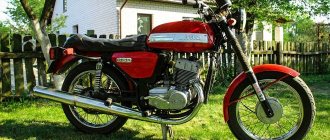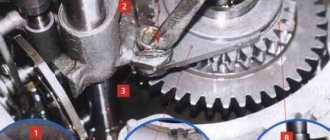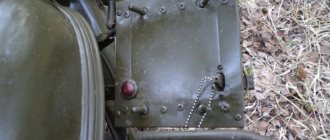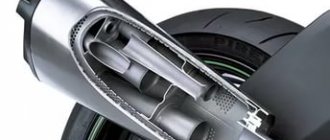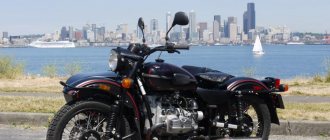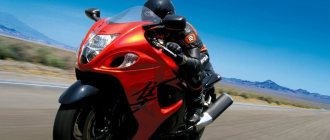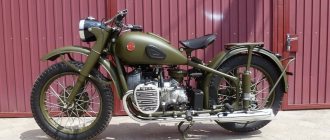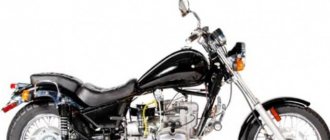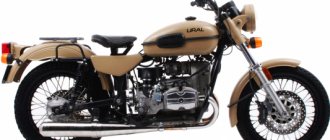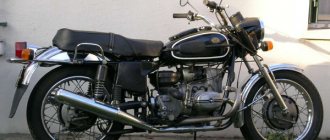I decided to share a story about my device. I met the motorcycle back in 2021, just after its restoration was completed by Kostya Korchagin from the Samara branch of MK Ural. I liked the motorcycle right away; there was something real about it that I couldn’t explain at the time. I myself rode “japas” back then, I was very pleased with the consumer qualities of these devices, but something was missing - the feeling of “toy-like” did not leave me, everything changed when I first found myself in the saddle of an M-61.
The motorcycle is rough, the suspension is hard, it’s not about comfort at all, it’s about something else. It’s at the level of sensations, it’s hard to put into words, it’s part of our history, a kind of fragment of the great past, the aesthetics of a retro motorcycle, in which there are no “assists”, amplifiers or other ABS, there is only you and the engine. At that moment, I decided that I really needed a motorcycle, although the rational part of my head said: “Why do you need it? Where can you go on a motorcycle that is almost 60 years old, it has manual fucking ignition timing! Yes, any trip will most likely become an unforgettable “adventure”. I thought like most owners of imported equipment. Still, I decided to buy it.
But the stars did not align at that moment and in the spring of 2021 he was bought by an interesting gentleman; it was his first motorcycle and he had a very indirect understanding of how to use an air-cooled motorcycle. As a result, abused over the summer by many hours of traffic jams, after many seizures and oil starvation, the engine died.
After grieving a little, I continued to ride soulless Jeeps, I had long ago forgotten about the motorcycle, but at the end of 2021 I received a fateful call - it was the same gentleman, the owner of the M-61, who offered me to buy it at half price. I borrowed money from friends, from anyone, for some reason I firmly believed that I needed this motorcycle like air. The owner assured that the motorcycle was able to get on and go and there was no need to do anything with it, he said this completely sincerely, there was no reason not to trust him. The equipment-money exchange has taken place!
Evening, end of October, the first thing I did was call my girlfriend with a proposal to ride around the city at night on a motorcycle with a cradle, to my surprise she immediately rushed over and we went. The feeling that the lower valve engine gave (yes, it so happened that since the 70s this motor had a motor from the K-750, which was included in the document book) is very interesting, first of all, it is, of course, a cool sound. After driving about 10 kilometers, I realized that the seller’s assurances, to put it mildly, were not true, the engine was overheating, despite the cold, the gears were falling out and in general the bike was rumbling, half of the electrics either worked or not. We ended up stuck in the middle of a major highway due to heat grab. Then reality hit me - the motorcycle needed to be repaired... all... completely.
I began to think about what I wanted from this motorcycle, there was a whole winter ahead, there was a lot to do before the season. It became clear that the stroller was not suitable for everyday use, there were always traffic jams in Samara, it was decided to make a single version, but I didn’t like the dynamics of the K-750 engine, I wanted something more. The idea finally took shape after the new year. We need a retro motorcycle, but with the performance qualities of more modern motorcycles, so that it is comfortable to move around the city at least 80-100 km/h. Having calculated the budget, I realized that the Japanese would have to be sold, because the cost of purchasing spare parts alone exceeded 100 thousand rubles. We immediately ordered custom valves, pistons from a BMW m20b20 80 mm, a crankshaft with a stroke of 88 mm, a camshaft that was calculated for me and sharpened to order, Keihin 32 carburetors, the same ignition “from Cap,” a bunch of gears for the box and gearbox.
The decision was made to return the appearance to almost factory condition. The problem was with the exhaust and steering wheel. The steering wheel was assembled in pieces, with return handles, a slider gas handle, and we had to buy an exhaust (a replica from Poland). I had to rework the seat mount a little, because... I could hardly reach the ground with my feet. Low profile retro tires were ordered. In April, the motorcycle was assembled, the engine was started, my joy knew no bounds.
A month has passed since the carburetors and valves were fine-tuned, and the 884 cc motorcycle actually started running! The first test of the engine took place on the way to the festival in Togliatti (about 100 km one way). Everything is fine, no sticking, excellent dynamics. I tried to attach a stroller to it, with such gear ratios it pulls it with difficulty, but it pulls! A motorcycle with a sidecar even took part in the rally.
The next trip was to Penza (450 km) for the “Motospring 2019” festival, I was traveling with a Japanese driver, we walked almost 120 all the way, everything was also fine. There was also a trip to Kirov (850 km) to the “Runway” fest, where I was able to meet and talk with the guys from the Chelyabinsk and St. Petersburg branches of the Ural MK. There were many small trips and not a single breakdown, everything worked like a Swiss watch) At the very end of the season, there was a short circuit somewhere and the wiring burned out, but the motorcycle still drove!!! And he brought me home.
The season is closed, winter is ahead again, Napoleonic plans again, how can I modernize my old friend so that he drives even more fun and looks even better. There's a lot of work ahead, a lot of investment, but it's worth it, it's a great bike to ride, I think I've found what I was looking for.
PS I would like to say about the opposition party in which I found myself involved. This is a very interesting world, a whole subculture within the motorcycle culture. For the most part, these are interesting and good people who have no show-offs (it’s hard to show off with old Urals), they help to the best of their ability, you meet people with incredible engineering thinking, sometimes you are amazed at what technical problems are solved and in what way. Here you are assessed not by the cost of your motorcycle and the most fashionable equipment, but by your human qualities, actions, skills, by how interesting, positive meanings you bring to this world.
Links
| This is a preliminary article about motorcycles. You can help the project by adding to it. |
K:Wikipedia:Articles without images (type: not specified)
| Sports motorcycles | M-35 • M-52S • M-52K • M-61K • M-62K • M-72K • M-75M • M-76 • M-77 • M-80 • K-1000 |
| Modern | Ural Ranger • Ural Sportsman • Ural Gear-Up • Ural Tourist • Ural Patrol • Ural T • Ural Retro • Ural M70 |
Nostalgia post
This post was inspired by a real life story. The parents moved to another apartment, where an elderly couple well over 80 had previously lived. The owners died, the daughter did not want to live there and bought another home. We agreed that she would take everything she wanted from the apartment, and she didn’t need the rest, so she could take it for herself or throw it away. As a result, she took all the furniture and appliances and put the rest in the storage room. And when I was sorting out this pantry, I subsequently found a large tin can, and in the can there were quite a lot of different decorations from Soviet times. I’ll say right away that there were no brilliant things there, but many of the little things really pleased me. Some items made me nostalgic for my childhood and my long-deceased grandmothers, who were the same age as the previous owner. Well, some things pleased me as a lover of vintage things. I especially liked a couple of necklaces and some brooches from Applenex from the 70s. I later sold some of that jar, gave some as a gift, and kept some for myself. And yesterday I had the chance to put on one of the left necklaces (well, I love retro and sometimes I wear things from my personal collection depending on the mood) and had a blast again. Therefore, I decided to share my nostalgia with you and remember what our mothers and grandmothers, and maybe we ourselves, used to wear. By the way, this is what I found (although not everything is in the photo)
All according to the classics of the genre. Beads from various stones, as well as bones, various brooches, metal bracelets, enamel, and ladies' delights jablonex from Czechoslovakia. Below I will add photos taken from the Internet, just for visual examples of previously popular jewelry.
Good old beads made from different stones. Many had garnet beads. My grandmother had exactly the same ones as in the photo below. Many people liked amber beads. True, not everyone could afford them, so plastic made to look like amber was also sold.
There were products made of bone; they are still made in the Arkhangelsk region in Kholmagory.
Products with enamel were quite popular. Necklaces, brooches, rings, bracelets. My grandmothers didn’t have these, but in the box they found there was a brooch and a ring.
Metal bracelets with various engravings were popular. Some were even sold as medicinal (I doubt their real benefits, but the power of suggestion works wonders). And whoever had money could afford Kubachi, silver with a beautiful blackening. My grandmothers had just metal ones.
For everyday wear, many chose beautiful jewelry. Fashionistas bought themselves jewelry from the Czechoslovak company Yablonex. They appeared here in the 50s, and sales peaked in the 70s. Necklaces, clips, brooches and even perfume bottles. I found exactly the same one in the box.
Not everyone could afford gold. Both in terms of money, and catching him was not always easy. Almost a symbol of the era became jewelry with corundums - large synthetic stones. One of my grandmothers had a ring like this.
More elegant were the decorations in the shape of the famous raspberries.
And here are the famous golden samovar earrings from the Riga plant.
And the famous sudarushka earrings.
Thanks to everyone who finished reading and had fun with me.
Technical characteristics of Ural M61
Length/width/height of the motorcycle - 2420/1650/1000 mm. The maximum load on this IMZ is 255 kg. The wheelbase of the bike is 1435 mm. Dry weight of the motorcycle is 360 kg. The maximum recommended speed is no more than 95 km. at one o'clock. The engine displacement is 649 cm3. The cylinder diameter is 78 mm. The piston stroke is 68 mm. Compression - 6.2 to 1. Motor power - 20.6 kW. The maximum crankshaft rotation speed is 4800 rpm. The volume of the gas tank is 22 liters. The oil volume in the motorcycle engine crankcase is 2 liters. The oil volume in the gearbox is 0.8 liters. The oil volume in the main gear housing is 0.15 liters. The oil volume in the air cleaner is 0.2 liters. The electrical system voltage is 6 volts.
- Back
- Forward
MADE IN USSR. HISTORY OF MOTORCYCLES URAL.
From Kaliningrad to Kamchatka there is not a person who has not heard about the Ural motorcycle. From the capital to a remote village, these heavy motorcycles are found everywhere.
Many people still associate the countryside with the smell of hay and the roar of the engine of grandfather’s old Ural. And my grandfather’s motorcycle itself seems so familiar and organic that it’s hard to believe in the true origin of this device. And he comes from Germany in the late 30s of the twentieth century.
At the end of the 30s of the twentieth century, the USSR army faced the need to equip reconnaissance and communications units with motorcycle transport. After analyzing the existing options, it was decided to take the German BMW R71 as a basis. There are two equal versions of how the BMW R 71 motorcycle came to Soviet engineers in 1939 and was copied by them. According to the first version, during the time of Nazi Germany’s flirtation with the Soviet Union, this model, among many other things, was transferred to the USSR for “familiarization.” According to the second version, the motorcycles were purchased by the NKVD special services in Sweden, then dismantled and transported to the USSR. The reliability of both versions is currently almost impossible to verify.
The first civilian model for Irbit motorcycle builders was the M-52. Its components and layout were already adapted for rapid movement on asphalt surfaces. It was driven by a reliable four-stroke 500cc engine. The Ural motorcycle engine produced 24 hp. and accelerated the motorcycle over 100 km/h. It was a unique utilitarian motorcycle that entered the trade. Moreover, each owner had to register his motorcycle with the military registration and enlistment office.
In 1957, the M-61 went into production. It differed from its predecessor in its increased all-terrain capability and was intended for village roads and light off-road use. For this motorcycle, the designers modified the engine, raising it to 28 hp. power and increased the volume to 650 cubic meters. Production continued until 1963.
In the 1970s, the designers of the IMZ plant followed the well-established trajectory - first they tested design innovations on the M-67, then increased the engine power, which is how the 36-horsepower version of the M-67-36 was created. To further increase engine power, a change in engine design was required.
The last real Soviet-designed Ural was the Ural 8.1O3-3O and 8.103-10, which were distinguished by gearboxes. One had reverse gear, the other did not.
URAL IMZ 8.103-10 AND 8.103-30
This was the last Soviet Ural, in fact there was a Ural solo, a wolf, a voyage, but that’s a completely different story
An excerpt characterizing the IMZ M-61
- Don't want! – Anatole answered, still continuing to smile. - Go, Balaga has arrived. Anatole stood up and entered the dining room. Balaga was a well-known troika driver, who had known Dolokhov and Anatoly for six years and served them with his troikas. More than once, when Anatole’s regiment was stationed in Tver, he took him out of Tver in the evening, delivered him to Moscow by dawn, and took him away the next day at night. More than once he took Dolokhov away from pursuit, more than once he took them around the city with gypsies and ladies, as Balaga called them. More than once he crushed people and cab drivers around Moscow with their work, and his gentlemen, as he called them, always rescued him. He drove more than one horse under them. More than once he was beaten by them, more than once they plied him with champagne and Madeira, which he loved, and he knew more than one thing behind each of them that an ordinary person would have deserved Siberia long ago. In their revelry, they often invited Balaga, forced him to drink and dance with the gypsies, and more than one thousand of their money passed through his hands. Serving them, he risked both his life and his skin twenty times a year, and at their work he killed more horses than they overpaid him in money. But he loved them, loved this crazy ride, eighteen miles an hour, loved to overturn a cab driver and crush a pedestrian in Moscow, and fly at full gallop through the Moscow streets. He loved to hear behind him this wild cry of drunken voices: “Go! let's go!" whereas it was already impossible to drive faster; He loved to pull the man's neck painfully, who was already neither alive nor dead, avoiding him. "Real gentlemen!" he thought. Anatole and Dolokhov also loved Balaga for his riding skill and because he loved the same things as they did. Balaga dressed up with others, charged twenty-five rubles for a two-hour ride, and only occasionally went with others himself, but more often he sent his fellows. But with his masters, as he called them, he always traveled himself and never demanded anything for his work. Only having learned through the valets the time when there was money, he came every few months in the morning, sober and, bowing low, asked to help him out. The gentlemen always imprisoned him. “Release me, Father Fyodor Ivanovich or your Excellency,” he said. - He’s completely lost his mind, go to the fair, lend what you can. Both Anatol and Dolokhov, when they had money, gave him a thousand and two rubles. Balaga was fair-haired, with a red face and especially a red, thick neck, a squat, snub-nosed man, about twenty-seven, with sparkling small eyes and a small beard. He was dressed in a thin blue caftan lined with silk, over a sheepskin coat. He crossed himself at the front corner and approached Dolokhov, extending his black, small hand. - Fyodor Ivanovich! - he said, bowing. - Great, brother. - Well, here he is. “Hello, your Excellency,” he said to Anatoly as he entered and also extended his hand. “I’m telling you, Balaga,” said Anatole, putting his hands on his shoulders, “do you love me or not?” A? Now you've done your service... Which ones did you come to? A?
